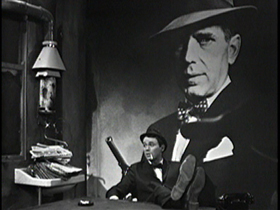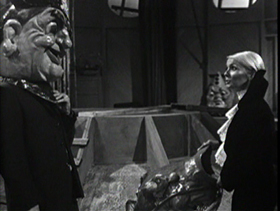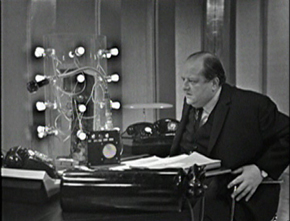
 |
|
|
|
I'm fairly well versed in the highpoints of British cult television but I'm sure that I'd never heard of The Corridor People until this DVD release was announced. Produced by Granada Television in 1966, The Corridor People is a highly original and quirky espionage series that has been favourably compared to The Avengers over the years. Such a comparison is highly appropriate: despite being produced on a smaller budget, The Corridor People largely succeeds in its efforts to match The Avengers in terms of eccentric characters, narrative weirdness and stylistic excess. Interestingly, the show's lead actress Elizabeth Shepherd had at one point been cast as Honor Blackman's replacement in The Avengers. Of the two shows, The Corridor People probably has the edge when it comes to the inclusion of more pointedly subversive and satirical political elements. The representations of the Ministry of Defence and the murky world of international relations and espionage included here are somewhat unflattering. By contrast, the show knowingly foregrounds early explorations of what are now referred to as personal politics. Discourses related to feminism and race/ethnicity are broached in frank but clever and thought provoking ways. Perhaps reflecting its northern roots (Granada Television was/is Manchester based), the show doesn't push the Swinging London vibe that is synonymous with most British espionage-related productions from the same period. Similarly, the show's theme music is a slice of downbeat jazz that has more in common with the music found in British social realist films than the groovy upbeat trumpet-driven music that is usually associated with British spy shows from the 1960s. 
I'll try to keep each episode's synopsis relatively brief in order to prevent major spoilers but that's not such an easy task: although the episodes only run to fifty minutes each, their quick pace and pop art plotting means that they tend to contain enough action, intrigue and narrative developments to fill a feature length film. Despite being only four episodes long, an abundance of recurring in-jokes, noticeable details and absorbing enigmas mean that the show can be aligned to cult television texts like The Prisoner and Randall and Hopkirk (Deceased). Anybody with a liking for the work of Robert Fuest (The Avengers, the Dr Phibes films, The Final Programme) should get a kick out of this show. Note: This DVD is a Web Exclusive that is only available directly from Network's homepage.

The Corridor People's decidedly eccentric nature is reflected in many of its recurring characters. Smartly dressed, officious and curt, the perpetually exasperated Kronk is a fairly typical head of department type. Scrotty, the American private detective, is another familiar type but his presence -- along with that of Department K's brutal interrogators -- allows the show to veer off into film noir-ish territory at times. The blundering Inspector Blood and Sergeant Hound both dress appropriately enough in Inspector Clouseau/Inspector Gadget-like outfits (trenchcoats, trilby hats, etc). Kronk's seemingly mouse-ish secretary, Miss Dunner (June Watson), doubles up as his most efficient assassin. Her skills on the shooting range really upset the alarmingly chauvinistic Major Ironside (Patrick Kavanagh), who duly vents his feelings of inadequacy to Kronk in a wholly disturbing and embarrassing manner. Syrie Van Epp is a really significant character: she's a pleasing mix of femme fatale and anti-heroine types. Her camp, cultured and aloof air, her flamboyant outfits, her talent for sniffing out big money deals and her ability to charm everyone with her mysterious foreign accent (supposedly Persian) all prompt comparisons to Yul Brynner's Sabata/Indio Black character. The show also features a raft of equally interesting guest characters. Windsor Davies (Carry On England), an actor best known for playing Welshmen, has a fun spot as a very proper Terry-Thomas-like Englishman. Aubrey Morris (The Wicker Man) is as animated and as intense as ever in his role as the drunken and deranged re-animator Robag while Calvin Lockhart (The Beast Must Die) is mannered but menacing as the dandified but determined Black Power leader Theobald Aboo. Nonesuch is a diminutive but hyperactive and super-vicious goon: he carries out one highly disturbing hit in an English park by posing as a child in a baby's carriage. Bo the Swedish film director is tagging along with Van Epp's gang in order to seek inspiration for his next film while Helena of Morphania uses her diplomatic immunity to shoplift to her heart's content. Pauline Collins (Shirley Valentine) plays Van Epp's fashion-conscious but equally mercenary and avaricious maid. Nina Baden-Semper's (Love Thy Neighbour) role as Pearl is relatively small but it remains groundbreaking. There can't have been many British television shows from 1966 that afforded a young black female character an affecting interior monologue and a chance to directly address the national audience with a pithy discourse about colour. 
Shot on videotape and studio-bound for the most part, The Corridor People is a somewhat theatrical production. Many of the show's sets (particularly Van Epp's pad and Scrotty's office) look like they were dressed by a theatre stage set designer. With allusions to normative realism willfully suspended, said set designs are, in the main, highly stylized. Phil Scrotty's office is really quite amazing: it features a huge mural of Humphrey Bogart on its far wall. Syrie Van Epp's pad looks like a room that you might find in Dr Phibes' London home and it must be said that some of Van Epp's glamorous outfits do bring to mind those worn by Phibes' assistant, Vulnavia. The influence of German expressionism can be mildly detected in the general look of Van Epp's goons' hideout, which is located on the top floor of a theatre. The place is littered with bizarre props that look like they belong to the Bonzo Dog Doo-Dah Band. The show's stylistic excesses extend to its cinematography: interestingly angled shots and showy blocking abound here. Similarly, the show's theatrical leanings reach as far as its mannered dialogue and its sometimes purposefully over-played acting. Some of the dialogue found here is really excellent, be it the farcical nonsense that Blood and Hound spout, the wry and witty Sam Spade/Philip Marlowe-style quips and wisecracks that Scrotty consistently delivers or the sometimes abstract interior monologues that some characters are allocated. The series also features a number of Brecht-inspired sequences where certain characters break the televisual fourth wall and speak directly to the camera and the audience. The use of direct address in film/television can come off as contrived and/or inappropriate but that's not the case with The Corridor People. In fact all of the various distanciation effects employed here sit quite comfortably within the show's knowing, semi-experimental and patently postmodern stylistic melange. It's this bold mix-and-match approach that ultimately serves to give the show a pleasingly eccentric identity all of its own. The nearest point of reference that I can think of in terms of its overtly theatrical, stagey and studio-bound feel would be the thematically unconnected British television series Rock Follies. All in all, The Corridor People is an important find for anybody interested in left field/cult television, 1960s espionage shows or British television history in general. 
Given The Corridor People's age and obscurity, the picture quality here is generally good but it does fluctuate a little. At its best it's just short of very good. However, it looks as though parts of this show were edited on-line/live in the studio and there are odd edits (mostly in the early sections of episode one) that prompt the picture to distort or wobble for a split second. In episode two a small amount of what appears to be tape wear-like damage is evident in the form of some very fine horizontal bands that appear briefly on a few occasions. The show's contrast levels fluctuate ever so slightly from time to time too. The show's sound quality also fluctuates a little but it generally remains good.
On a scale of Excellent, Good, Fair, and Poor,
Reviews on the Savant main site have additional credits information and are often updated and annotated with reader input and graphics. Also, don't forget the 2010 Savant Wish List. T'was Ever Thus.
Review Staff | About DVD Talk | Newsletter Subscribe | Join DVD Talk Forum |
| ||||||||||||||||||